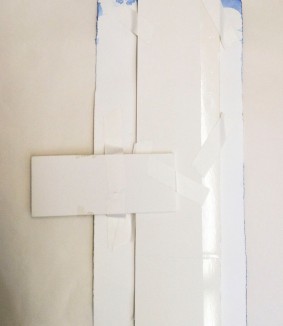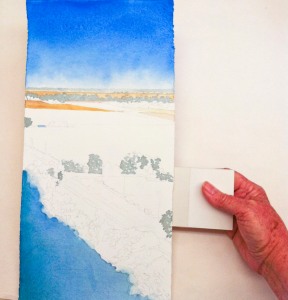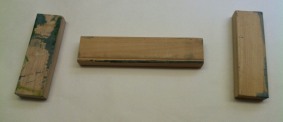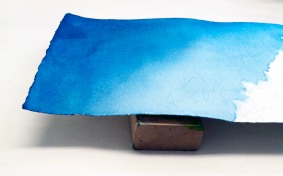Here are some detailed photos of how I overcame the challenges of painting to the deckle edge as described in an earlier post. (A deckle edge is the natural feathered edge from when the paper was made).
 Step 1
Step 1
I cut a foam core board just smaller than my watercolor paper and taped it to the back using white removable art tape. Since the paper isn’t stretched this gives support to the paper so it won’t sag or flop while wet. It needs to be about ½ inch smaller so the edges of the paper won’t touch the foam core board, otherwise a backwash will occur at the edge. It also gives a place to tape the paper on the back. Also tape an extension or “handle” at one or two strategic points. This should be on an edge area that will not have a wet wash, or after you have done one area that has dried. You can add or detach a “handle” as needed. I usually keep it on until I’m done with the painting so that I don’t have to touch the art.

Step 2
This demonstrates how the art can be handled without touching it and can be manipulated while wet.
Step 3
Cut some wood blocks in a variety of lengths so that you can support the art underneath while the wash dries. This keeps the art raised so that it doesn’t touch the table. My blocks are about ¾” thick by 2” wide and assorted lengths. Keep the art on the blocks until the paper is dry. I paint on the blocks when I do a large wash, but sometimes the foam core board is enough to raise the paper by itself without having to use the blocks. It just depends on how much the paper is curling while wet.
For those readers who aren’t artists, this is one reason why watercolors are so difficult versus painting on a canvas with oils or acrylic. It’s also why few watercolorists paint to the edge and instead stretch paper on a wooden board. The warped paper creates many challenges, such as pooling. Some artists paint on heavier paper, but it is more expensive and I haven’t found a paper that is sized the way I like it. The heavier paper tends to be more absorbent and really soaks up the paint. I hope this gives a better understanding of this method. It has definitely helped me manage the problem. Has anyone else found another way to deal with this? I’d be interested to hear about your tips!


